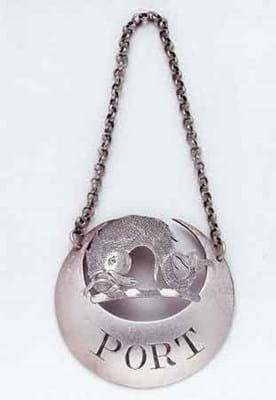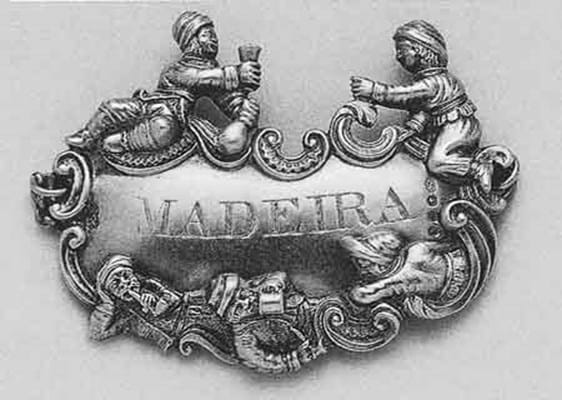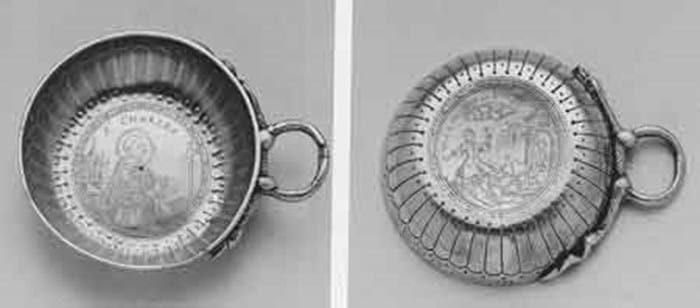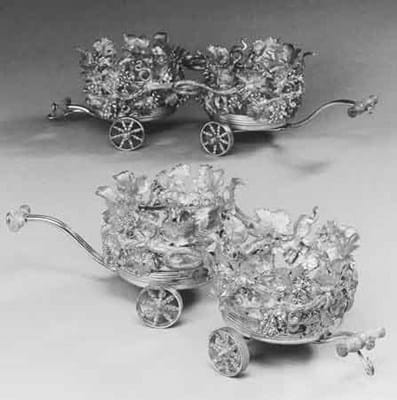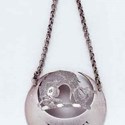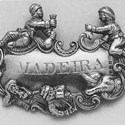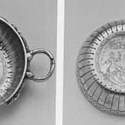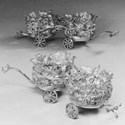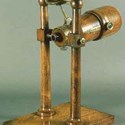For this popular collecting field, the dispersal on October 1 ranked comfortably among the best offerings of its type in recent memory.
Predictably members of the Wine Label Circle turned out in force. Along with what the auctioneers termed "plenty of new faces" - a mix of Harvey's memento seekers and oenophiles looking for unusual purchases - they were instrumental in producing a near sell-out with just two of the 199 lots of silver left unsold. The sale netted just under £170,000.
Wine labels weren't the only items on offer in this afternoon session (bottle stands, wine funnels tasters and coolers also featured), but they were its mainstay, swelled by the elements from the massive collection formed by Edward Pratt, a founder member of the Wine Label Circle.
The label selection contained a wide variety of different examples of unusual names, shapes and desirable makers, as well as plenty of more representative models. Accordingly it offered something for everyone, from beginners to seasoned collectors.
In the rarities class came two heraldic labels. One crescent shaped for Port marked for the well-known Phipps and Robinson partnership 1799 had a dolphin naiant between the crescent horns (a crest shared by several different families). The other, for Burgundy, was unmarked (many armorial labels were not assayed) but, confidently dated to c.1790, was fashioned as a sun in splendour charged with an armed foot, the badge of Blount of Soddington, Worcestershire. Both of these easily outstripped expectations to sell for £2200 and £1800.
Some very grand crescent shaped labels in silver-gilt fashioned as lions' pelts with fruiting vine, by Paul Storr, were predictably also up amongst the top lots, with a pair for Claret and Madeira marked for 1815 fetching a double-estimate £6000 and a single example for Sherry of 1816 making £2100. A fourth example for Claret to the same pattern but in silver came in at a more modest £650, just under low estimate. Also in demand at £1200 was a large 3in (7.5cm) wide cast label of extravagant design by Edward Farrell, a well-regarded maker, 1842, fashioned as two topers toasting one another with other Teniers-type tavern characters to the bottom.
Equally there were plenty of opportunities to buy attractive individual labels for under £200 or, in the case of the sauce labels, to purchase small groups ranging from four to 13 specimens for under £500.
Aside from the rarest labels, the big spending in this auction was done in the other sections amongst the early French wine tasters and most dramatically with a pair of silver-gilt double coaster trolleys fashioned as intertwining branches of fruiting vine, Benjamin Smith II hallmarked for 1828. This elaborate Regency design is always popular when it comes up for sale and the Harvey's model, which bore arms for Sir Jacob Astley, took £72,000.
Attractive rarities
Most of the 30-odd wine tasters in the sale were French 18th century models, the most expensive of which was an attractively engraved example at £2400, but there were some British rarities that were keenly sought, none more than the porringer shaped William and Mary period taster of c.1690, maker's mark HE conjoined, with "snakeskin" finish to the lower section, that trebled expectations, selling for £3200.
The Arts, Craft and Science of Wine, the third auction from Harvey's Wine Museum on October 2, was the most eclectic of the series and netted just over £122,000 with 252 of the 265 lots finding buyers. It took in furniture, artwork for wine lists and other pictures, corkscrews and scientific instruments used in the manufacture and bottling of wine but also enamel and ceramic bin and bottle labels.
Many of the latter were from the collection of George Delaforce of the Delaforce Port family. These had been on loan to Harvey's Museum and were offered for sale by his family.
Top price of £3400 went as expected to a mid-18th century Battersea enamel wine label for White Portdecorated with a design of two putti treading grapes based on an engraving by Simon François Ravenet.
The auctioneers hadn't, however, predicted quite such high prices for some of the 'coathanger' shaped labels fashioned in English delft. Including the names of arcane beverages such as Picolito, Calcavella, Mountain and Neckar, these attracted considerable attention, including interest from specialist pottery dealers, and several were pursued to £1850 apiece.
Another ex-Delaforce piece that was much in demand was a rosewood decanting machine for vintage port thought to be probably French and of early 19th century date that was pursued to £9000.
The buyer's premium was 19.5/10%.

